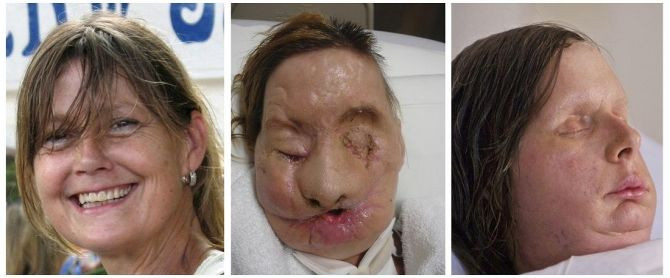Surgeons Report US Face Transplant Details

This year three People received the first full-face transplants in the U.S. at the Brigham and Women’s Hospital in Boston, and details on their extensive procedures were reported on Wednesday.
Medical procedures are extremely complicated in such transplants, and they include grafting of not just the skin but of nerves, muscles, blood vessels and nose-like structures, according to the report published in the New England Journal of Medicine.
The report documented the transplants of Dallas Wiens, Mitch Hunter, and Charla Nash. Wiens, a 26-year-old Texas man, accidentally struck a power line while he was painting a church. Hunter of Indiana lost most of his face in a car accident. Nash was mauled by her neighbor’s chimpanzee. Doctors have said that all three of the FFT patients well on their way to recovery.
"Unlike conventional reconstruction, facial transplantation seeks to transform severely deformed features to a near-normal appearance and function that conventional reconstructive plastic surgical techniques cannot match," said lead author Dr. Bohdan Pomahac director of the surgery transplantation program at the hospital where the transplants were performed. "It truly is a life-giving procedure for these patients."
Pomahac said that the main problem that surgeons encountered had been the belief that they needed to connect four arteries and an equivalent number of veins to provide sufficient blood flow for transplanted tissues.
However, surgeons found a simpler method of connecting just one artery and one vein on each side of the face. Surgeons also connected all the focal motor and sensory nerves to restore function to the transplanted face.
Physicians had to meticulously screen all potential candidates that needed the transplant procedure. Patients had to take physical and psychological tests to ensure that they were mentally and physically capable of going through with the surgery.
The report described how surgeons had to work with numerous hospital staff members as well as other clinicians to prepare the patient for the procedure while also preparing the donor tissue simultaneously.
After the surgery was performed, doctors had to constantly monitor the patients’ recovery by adjusting and tailoring their immunosuppressant medications so that their body would accept, rather than reject the new faces.
Both Hunter and Nash experienced an episode of rejection, and were treated with more immunosuppressant drugs. All three patients were diagnosed and treated with infections from the surgery.
The procedures were all generally successful, and the transplanted faces have actually transformed and adapted to match the features of all three patients, according to the study.
"Our focus moving forward continues to be on monitoring and documenting the progress of patients who have undergone FFT, and refining the use of immunosuppressants, with the hope that one day patients will eventually need to take little or none," Pomahac said.
According to the study, since 2005, 18 patients have received face transplants with good results; however most were performed to restore partial face defects.
Published by Medicaldaily.com



























